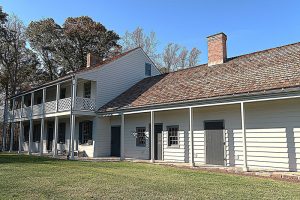 Nestled on 27 acres on the west side of Laurel Avenue, between Rocky Hill and Kingston, is the historic house, Rockingham. The house served as General George Washington’s final wartime headquarters during the Revolutionary War. Washington stayed at the house from August 23rd to November 10th of 1783 while Congress met in Princeton. Although Rockingham is famed for Washington’s stay, the house’s story stretches back long before 1783 and ahead many more years. The house had many owners over its long history before it became a part of New Jersey State Parks, Forests & Historic Sites. And it no longer sits in its original location, having been moved three times in its history.
Nestled on 27 acres on the west side of Laurel Avenue, between Rocky Hill and Kingston, is the historic house, Rockingham. The house served as General George Washington’s final wartime headquarters during the Revolutionary War. Washington stayed at the house from August 23rd to November 10th of 1783 while Congress met in Princeton. Although Rockingham is famed for Washington’s stay, the house’s story stretches back long before 1783 and ahead many more years. The house had many owners over its long history before it became a part of New Jersey State Parks, Forests & Historic Sites. And it no longer sits in its original location, having been moved three times in its history.
The original section of the house, a saltbox design, dates to around 1710 and was constructed by the Higgins family. The original land is now part of Trap Rock Quarry in Rocky Hill.
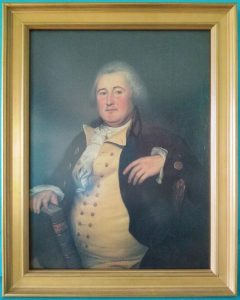 By 1735, John Berrien, a surveyor from Long Island, purchased the property. Berrien climbed up the social and political ladder during his ownership. In 1764, he was appointed Superior Court Justice for the Colony of New Jersey. Berrien also expanded the property and the house in the 1760s, adding a kitchen wing and a one-and-a-half story section. John Berrien died in 1772, leaving Rockingham to his wife, Margaret Eaton Berrien, and their six children. She put the house and land up for sale in 1783 as the Revolutionary War ended and the children came of age to inherit.
By 1735, John Berrien, a surveyor from Long Island, purchased the property. Berrien climbed up the social and political ladder during his ownership. In 1764, he was appointed Superior Court Justice for the Colony of New Jersey. Berrien also expanded the property and the house in the 1760s, adding a kitchen wing and a one-and-a-half story section. John Berrien died in 1772, leaving Rockingham to his wife, Margaret Eaton Berrien, and their six children. She put the house and land up for sale in 1783 as the Revolutionary War ended and the children came of age to inherit.
Congress was meeting in Philadelphia in the summer of 1783, awaiting the news on the treaty to end the war. However, after disgruntled Pennsylvania-line soldiers, who had been recently furloughed, mutinied over not being paid, Congress evacuated and settled in Princeton, meeting in Nassau Hall. They requested that Washington send troops to suppress the mutiny and then invited him to Princeton to meet and discuss matters relating to the end of the war.
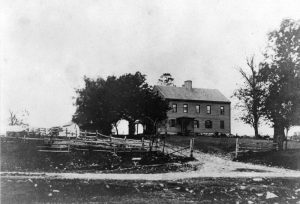 Washington, who was with the main army near West Point, accepted the invitation and Congress rented Rockingham, which was up for sale, for Washington’s use. Washington arrived on August 23rd, accompanied by his wife Martha, three military secretaries, his lifeguard and “domesticks”, including free servants and enslaved. His stay was a time of relaxation and reflection. The Washingtons entertained guests and socialized in Princeton. The general often attended sessions of Congress. He and his aides maintained a military headquarters at the home.
Washington, who was with the main army near West Point, accepted the invitation and Congress rented Rockingham, which was up for sale, for Washington’s use. Washington arrived on August 23rd, accompanied by his wife Martha, three military secretaries, his lifeguard and “domesticks”, including free servants and enslaved. His stay was a time of relaxation and reflection. The Washingtons entertained guests and socialized in Princeton. The general often attended sessions of Congress. He and his aides maintained a military headquarters at the home.
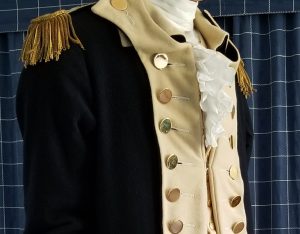 In mid-October, Congress issued a proclamation that the remainder of the army would be discharged, beginning on November 3. In response to this, Washington issued his own document, The Farewell Orders to the Armies of the United States. The Orders primarily addressed three concerns: to praise the army as a whole and acknowledge the miraculous feat they had accomplished in gaining the colonies’ independence through many hardships and by facing one of the greatest professional armies in the world (which they were not!); to give advice to the men returning from war back to their communities, on their future conduct and hopes for their easy reintegration into those communities; and to plainly state what would come next for him, how “the Commander in Chief is about to retire from service–The Curtain of separation (sic) will soon be drawn–and the Military Scene to him will be closed for ever.” This was a shocking decision to step away from great power in a time when the norm was for victorious military leaders to make themselves kings or emperors of the lands over which they had won. Washington’s decision set him apart in history and earned him great respect, even from King George III of Great Britain, who mourned the loss of the American colonies.
In mid-October, Congress issued a proclamation that the remainder of the army would be discharged, beginning on November 3. In response to this, Washington issued his own document, The Farewell Orders to the Armies of the United States. The Orders primarily addressed three concerns: to praise the army as a whole and acknowledge the miraculous feat they had accomplished in gaining the colonies’ independence through many hardships and by facing one of the greatest professional armies in the world (which they were not!); to give advice to the men returning from war back to their communities, on their future conduct and hopes for their easy reintegration into those communities; and to plainly state what would come next for him, how “the Commander in Chief is about to retire from service–The Curtain of separation (sic) will soon be drawn–and the Military Scene to him will be closed for ever.” This was a shocking decision to step away from great power in a time when the norm was for victorious military leaders to make themselves kings or emperors of the lands over which they had won. Washington’s decision set him apart in history and earned him great respect, even from King George III of Great Britain, who mourned the loss of the American colonies.
At the cusp of November, Washington and Congress received word that the Treaty of Paris, formally ending the Revolutionary War, had been signed on September 3 and our Declaration of Independence was finally fulfilled. Washington left Rockingham, returning to the main army encamped by West Point; to oversee their disbandment and the evacuation of New York City by the British Army (their headquarters during the war). He finally turned his sights homeward, leaving New York in early December, resigning his commission to Congress in Annapolis and arriving home to Mount Vernon on Christmas Eve, 1783, under the contented expectation that he was retiring from public life.
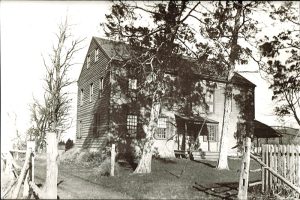 Mrs. Berrien finally sold Rockingham to the Cruser family in 1802. Their renovations brought the house close to what it is today. After several other owners, Martin Howell acquired it in 1872, expanding the quarrying that was already ongoing in the area.
Mrs. Berrien finally sold Rockingham to the Cruser family in 1802. Their renovations brought the house close to what it is today. After several other owners, Martin Howell acquired it in 1872, expanding the quarrying that was already ongoing in the area.
In 1896, due to house disrepair and rumors of its being torn down, Kate MacFarlane and Josephine Swann led the formation of the Washington Headquarters Association, buying and moving the house off of quarry property and then opening it to the public. After they gave it to the State of New Jersey in 1935, the State moved it again in 1957 and once more in 2001, to its present location, to protect it from damage due to quarry blasting.
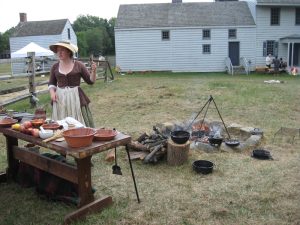 Today, Rockingham sits next to D&R Canal State Park. Visitors can explore inside the house by reserving one of three free guided tours. Our regular house tour focuses on Washington’s stay, during which visitors will walk through rooms that are imbued with a lived-in feel, with period furnishings, décor and little touches of character, as well as reproductions of Washington military and personal equipment. Our life-size mannequins of the General and Mrs. Washington enable you to imagine what it was like to meet them in person. One can also opt for one of our two more-limited tours: “The Evolution of Rockingham,” which takes a more in-depth look at the history of the house itself and the other owners who shaped it or, “Meeting Lady Washington,” which illuminates the life of Martha Washington, steadfast helpmate to George and a capable manager in her own right, from birth to final rest. We have also had Washington Birthday Trivia Tours and, while it has been a while, candlelight holiday tours.
Today, Rockingham sits next to D&R Canal State Park. Visitors can explore inside the house by reserving one of three free guided tours. Our regular house tour focuses on Washington’s stay, during which visitors will walk through rooms that are imbued with a lived-in feel, with period furnishings, décor and little touches of character, as well as reproductions of Washington military and personal equipment. Our life-size mannequins of the General and Mrs. Washington enable you to imagine what it was like to meet them in person. One can also opt for one of our two more-limited tours: “The Evolution of Rockingham,” which takes a more in-depth look at the history of the house itself and the other owners who shaped it or, “Meeting Lady Washington,” which illuminates the life of Martha Washington, steadfast helpmate to George and a capable manager in her own right, from birth to final rest. We have also had Washington Birthday Trivia Tours and, while it has been a while, candlelight holiday tours.
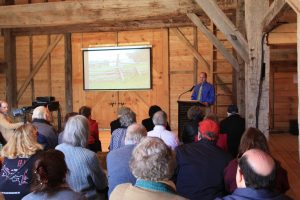 There have been reenactor encampments and a children’s Day of activities on the grounds. The grounds of the site include other buildings as well as the main house: an 18th-century wash house/summer kitchen and a barn that is open on Sundays for visitors to drop in and see its mortise-and-tenon construction. The barn has also been the scene of presentations on varied topics such as chocolate, food preservation, beekeeping, country dance, Revolutionary War- and canal-era music as well as first-person programs like “George and Martha Washington: A Love Story.” There is a stone building built at the second location that now serves as our museum store with public bathrooms attached.
There have been reenactor encampments and a children’s Day of activities on the grounds. The grounds of the site include other buildings as well as the main house: an 18th-century wash house/summer kitchen and a barn that is open on Sundays for visitors to drop in and see its mortise-and-tenon construction. The barn has also been the scene of presentations on varied topics such as chocolate, food preservation, beekeeping, country dance, Revolutionary War- and canal-era music as well as first-person programs like “George and Martha Washington: A Love Story.” There is a stone building built at the second location that now serves as our museum store with public bathrooms attached.
Come join us at Rockingham, the home that served as Washington’s final wartime headquarters, and where he formally renounced any claim to being crowned king of our new country!
Ryan Thiel is an Historic Educator at Rockingham State Historic Site. He is a recent graduate of Rowan University with a B.A. in history. He has worked at Rockingham since April 2024.
